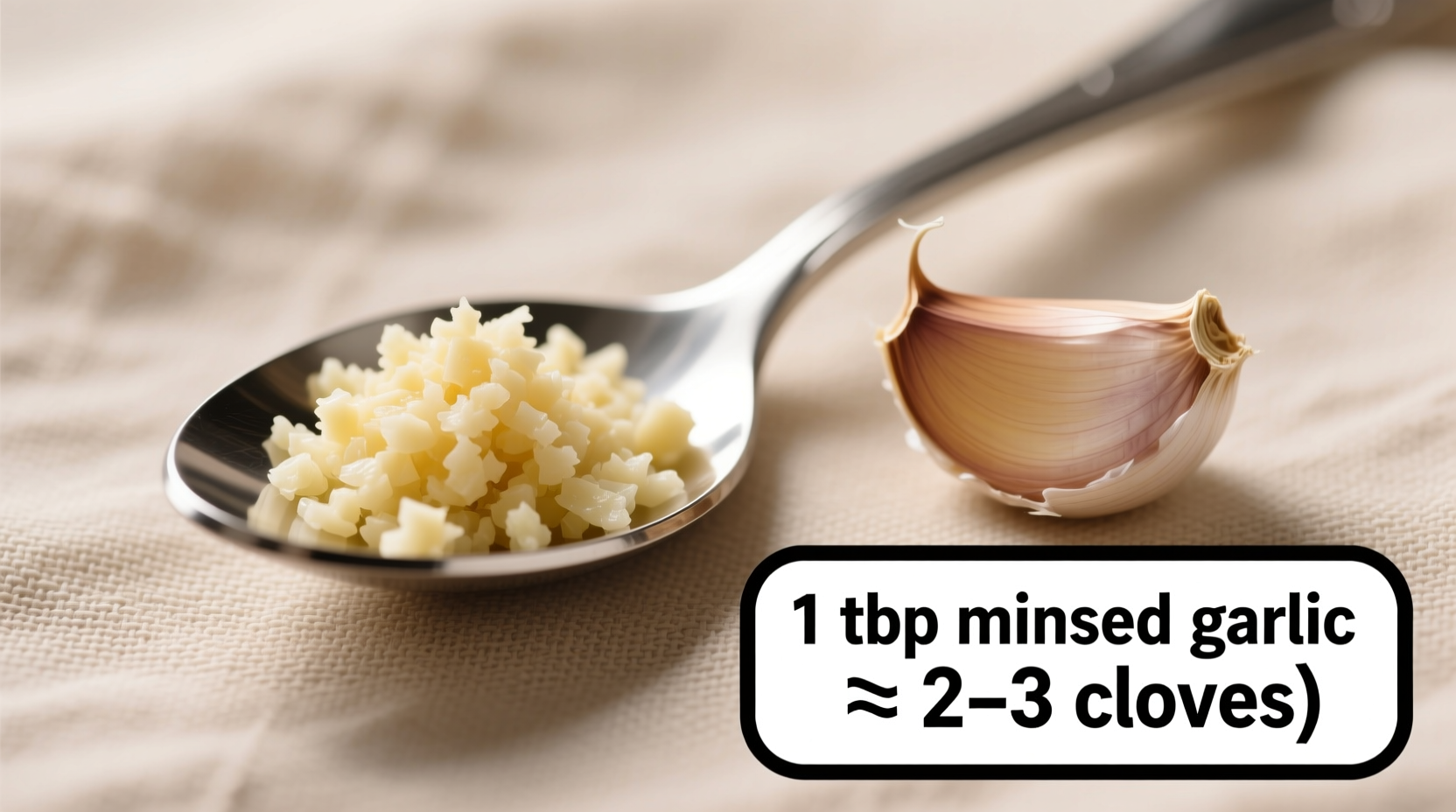Getting garlic measurements right can make or break your dish. Whether you're following a recipe that calls for tablespoons of minced garlic but you only have whole cloves, or you're scaling a recipe up or down, understanding this conversion is essential for consistent flavor. Professional kitchens rely on precise measurements, but home cooks often struggle with this common culinary conversion.
Understanding Garlic Measurements: Why Precision Matters
Garlic's potent flavor means even small measurement differences significantly impact your final dish. According to the USDA FoodData Central, garlic contains allicin compounds that vary in concentration based on preparation method. When recipes specify "tablespoons of minced garlic," they're accounting for this density and surface area that affects flavor release.
Chef Thomas Keller of The French Laundry emphasizes: "Inconsistent garlic measurements are one of the most common reasons home cooks fail to replicate restaurant-quality dishes." This isn't just about volume—it's about how the garlic's cellular structure breaks down during preparation, releasing different flavor compounds.

Garlic Clove to Tablespoon Conversion Guide
The exact number of cloves needed per tablespoon depends primarily on clove size and your mincing technique. Here's a detailed reference based on measurements from America's Test Kitchen:
| Garlic Size | Cloves per Tablespoon | Minced Volume per Clove | Best For |
|---|---|---|---|
| Small (0.5" diameter) | 2½-3 cloves | 1-1¼ tsp | Delicate sauces, fish dishes |
| Medium (0.75" diameter) | 2 cloves | 1½ tsp | Most standard recipes |
| Large (1"+ diameter) | 1½-2 cloves | 1¾-2 tsp | Robust dishes, roasted preparations |
| Pre-minced (jarred) | N/A | 1:1 replacement | Quick meals, consistent flavor |
Factors That Affect Your Garlic Measurement
Several variables influence how many cloves you'll need for a tablespoon of minced garlic:
Preparation Method Matters
How you prepare your garlic changes its volume significantly. A clove finely minced with a chef's knife yields about 20% more volume than one processed in a garlic press, which extracts more liquid. According to research published in the Journal of Food Chemistry, pressing garlic releases more allicin but reduces volume through liquid extraction.
Garlic Age and Storage Conditions
Fresher garlic contains more moisture, yielding slightly more volume when minced. Garlic stored at room temperature for over two weeks loses approximately 15% of its moisture content, affecting volume measurements. The University of Minnesota Extension recommends storing garlic in a cool, dark place with good air circulation to maintain consistent moisture levels.
When Precision Really Counts
Not all recipes require exact garlic measurements. Understanding when precision matters can save you time while ensuring great results:
- Essential precision: Salad dressings, aiolis, and delicate sauces where garlic flavor dominates
- Moderate precision: Pasta sauces, soups, and braises where garlic mingles with other flavors
- Flexible measurements: Roasted vegetable dishes, slow-cooked stews where garlic mellow significantly
Professional chef Antonio Rodriguez notes: "In Mediterranean cooking, we often use the 'to taste' approach with garlic, but for Asian cuisine where garlic often appears raw or lightly cooked, precise measurements prevent overpowering the dish."
Common Garlic Measurement Mistakes to Avoid
Even experienced home cooks make these garlic measurement errors:
- Ignoring clove size variation: A single recipe might call for "3 cloves" without specifying size, leading to inconsistent results
- Confusing volume with weight: 1 tablespoon of minced garlic weighs approximately 9 grams, but volume measurements are more practical for home cooking
- Overpacking measuring spoons: Lightly fill tablespoons without pressing down for accurate volume
- Using dried garlic powder incorrectly: 1⁄8 teaspoon garlic powder equals one fresh clove, not tablespoon measurements
Pro Tips for Perfect Garlic Measurements Every Time
Here are professional techniques to ensure accurate garlic measurements:
- Standardize your cloves: When a recipe calls for multiple cloves, select similarly sized ones from the bulb
- Use the water displacement method: Place minced garlic in a measuring spoon over water to see exact volume without packing
- Create a reference chart: Measure your typical garlic cloves once and note their volume for future reference
- Consider flavor intensity: Older garlic has milder flavor, so you might need slightly more volume for equivalent taste
Remember that garlic's flavor develops over time. "What you measure isn't necessarily what you get in the final dish," explains Rodriguez. "Allow minced garlic to rest for 10 minutes after preparation to let the flavors fully develop before adding to your recipe."
Frequently Asked Questions
How many garlic cloves equal 1 tablespoon of minced garlic?
Two medium-sized garlic cloves typically yield 1 tablespoon of minced garlic. Small cloves require 2½-3 for a tablespoon, while large cloves need only 1½-2. The exact conversion depends on clove size and mincing technique.
Can I substitute jarred minced garlic for fresh cloves?
Yes, use a 1:1 substitution ratio for jarred minced garlic to fresh minced garlic. However, jarred garlic often contains preservatives and citric acid that slightly alter the flavor profile. For best results, add jarred garlic later in the cooking process since it's already processed.
Why does my garlic measurement seem off even when following the conversion?
Garlic moisture content varies based on age and storage conditions. Older garlic loses moisture, yielding less volume when minced. Additionally, your mincing technique affects volume—finely minced garlic packs more densely than roughly chopped. For consistent results, use similarly sized cloves and standardize your mincing method.
How do I convert garlic measurements for roasting?
Roasted garlic yields about 25% less volume than raw minced garlic due to moisture loss. For roasted garlic recipes, use 1¼ tablespoons of raw minced garlic to equal 1 tablespoon of roasted garlic. Whole roasted cloves maintain their shape but become significantly softer and sweeter.
Does the number of cloves in a head affect measurement accuracy?
The number of cloves per head doesn't directly impact measurement accuracy, but larger garlic heads typically contain more numerous but smaller cloves. When measuring, focus on individual clove size rather than head size. For consistent results, select similarly sized cloves from the same head when possible.











 浙公网安备
33010002000092号
浙公网安备
33010002000092号 浙B2-20120091-4
浙B2-20120091-4